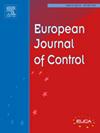受硬驱动约束的多输入多输出系统严格跟踪控制渐近稳定性问题的数值解
IF 2.6
3区 计算机科学
Q2 AUTOMATION & CONTROL SYSTEMS
引用次数: 0
摘要
由牛顿力学控制的非线性多输入多输出(MIMO)系统在跟踪控制设计方面面临着重大挑战,特别是由于执行器饱和约束会产生无效的控制输入,从而破坏系统的渐近稳定性。本文提出了一种新的跟踪控制算法,既保证了系统的稳定性,又满足了执行器的限制。该方法将连续时间动力学转换为离散时间框架,通过将微分方程替换为代数方程来提高计算效率。为每个输出引入具有动态可调参数的滑动面以优化跟踪性能,并使用功率达到律推导控制输入,分为位置和速度模式,有助于减少执行器功率和超调/欠调。通过凸不等式约束明确地解决了两种模式的致动器饱和问题,使最优的期望轨迹能够返回尊重输入限制的可行控制输入,同时保持渐近稳定性。搜索机制优化滑动和功率到达参数,以最小化跟踪误差,使修改后的轨迹与参考轨迹对齐。数学证明证明了闭环系统的渐近稳定性和修正轨迹对参考轨迹的收敛性。通过比较研究的MATLAB仿真证实了精确的跟踪,对参数不确定性的鲁棒性,以及对饱和度约束的遵守,无需手动调整和预置。这种自调整能力将该方法与依赖于经验调整的现有方法区分开来。实时执行分析验证可行性,满足0.01秒的执行目标。考虑到实时执行评估显示的搜索网格强度与计算负荷之间的二次关系,因为它提供了参数选择的基准,能够有效地平衡控制性能和实时可行性的严格要求。该算法适应不同的优化技术,以平衡计算负荷和跟踪精度,为控制存在各种约束的复杂非线性MIMO系统提供了一个标准化的通用框架。本文章由计算机程序翻译,如有差异,请以英文原文为准。
Numerical solution for strict tracking control asymptotic stability problem of MIMO systems manipulated by hard actuation constraints
Nonlinear Multi-Input Multi-Output (MIMO) systems governed by Newtonian mechanics face significant challenges in tracking control design, especially due to actuator saturation constraints that can undermine asymptotic stability by yielding nullified control inputs. This paper proposes a novel tracking control algorithm ensuring stability and compliance with actuator limitations. The approach transforms continuous-time dynamics into a discrete-time framework, enhancing computational efficiency by replacing differential equations with algebraic ones. A sliding surface with dynamically tunable parameters is introduced for each output to optimize tracking performance, and control inputs are derived using a power reaching law, split into position and velocity modes which helps reducing actuator power and overshoot/undershoot. Actuator saturation is explicitly addressed for both modes through convex inequality constraints, enabling an optimal desired trajectory to return feasible control inputs that respect input limits while preserving asymptotic stability. A search mechanism optimizes sliding and power-reaching parameters to minimize tracking error, aligning the modified trajectory with the reference. Mathematical proofs establish the closed-loop system’s asymptotic stability and convergence of modified trajectory to reference trajectory. MATLAB simulations included by comparative investigations confirm precise tracking, robustness against parametric uncertainties, and adherence to saturation constraints, achieved without manual tuning and pre-setting. This self-tuning capability, distinguishes the method from existing approaches reliant on empirical adjustments. Real-time execution analysis validates feasibility, meeting a 0.01-second execution target. Given the quadratic relationship between search gridding intensity and computational load demonstrated through real-time execution assessment, as it provides a benchmark on parameter selection, enabling an effective balance between control performance and stringent demands of real-time feasibility. The algorithm’s adaptability to different optimization techniques to balance computational load and tracking accuracy, offers a standardized, versatile framework for controlling complex nonlinear MIMO systems in the presence of various constraints.
求助全文
通过发布文献求助,成功后即可免费获取论文全文。
去求助
来源期刊

European Journal of Control
工程技术-自动化与控制系统
CiteScore
5.80
自引率
5.90%
发文量
131
审稿时长
1 months
期刊介绍:
The European Control Association (EUCA) has among its objectives to promote the development of the discipline. Apart from the European Control Conferences, the European Journal of Control is the Association''s main channel for the dissemination of important contributions in the field.
The aim of the Journal is to publish high quality papers on the theory and practice of control and systems engineering.
The scope of the Journal will be wide and cover all aspects of the discipline including methodologies, techniques and applications.
Research in control and systems engineering is necessary to develop new concepts and tools which enhance our understanding and improve our ability to design and implement high performance control systems. Submitted papers should stress the practical motivations and relevance of their results.
The design and implementation of a successful control system requires the use of a range of techniques:
Modelling
Robustness Analysis
Identification
Optimization
Control Law Design
Numerical analysis
Fault Detection, and so on.
 求助内容:
求助内容: 应助结果提醒方式:
应助结果提醒方式:


